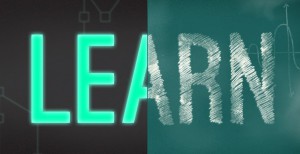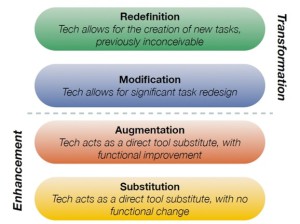
flickr photo by opensourceway shared under a Creative Commons (BY-SA) license
In the face of the myriad of technologies available to support teaching and learning, considered approaches to the planning of activities and integration of technology into curricula have never been more important.
Universities across the sector have invested in specialist learning technology provision to aid this process while initiatives such as the Jisc Building Digital Capability project have provided individuals and institutions with the means of evaluating digital skills, informing training provision and shaping the development of professional practice.
When transitioning to the digital environment and seeking to embed technology in teaching it’s crucial to reflect on your pedagogical goals before progressing to think about the practical implementation of technology in your practice. What is it that you want students to do/learn using technology? What level of engagement are you looking to achieve?
Learning Design
A number of learning design methodologies and frameworks exist that explicitly consider the role of technology in teaching and learning activities. In a complex and fast-changing educational landscape these educational frameworks can represent useful pedagogical tools to support the evaluation and evolution of practice.
Two examples of such methodologies are:
- 7Cs of Learning Design– originally developed by Professor Grainne Conole as part of the Open University’s Learning Design Initiatve, the 7Cs of Learning Design Framework breaks down the design process into stages moving from initial conceptualisation through to consolidation where the effectiveness of the design is evaluated. The framework was further developed at the University of Leicester and published openly licenced toolkit to support technology enhanced learning.
- SAMR Model – developed by Dr Ruben Puentedura, SAMR

Image the creation of Dr. Ruben Puentedura, Ph.D. http://www.hippasus.com/rrpweblog
represent a non-linear four stage model designed to help teachers
effectively integrate technology into learning activities. Each stage – Substitution, Augmentation, Modification and Redefinition – is indicative of higher levels of learner engagement. Use of technology at the Modification or Redefinition level is viewed as a transformation in practice. At the Substitution and Augmentation levels technology use represents an enhancement but with little or no function change in practice.
There are of course limitations in these frameworks and indeed in many other educational taxonomies. They represent however useful tools to conceptualise new activities or reconceptualise existing approaches. They prompt us to think about the impact of technology adoption, our own digital capabilities and those of our learners, and the nature of the engagement that the use of technology might facilitate.
There is growing body of research in this area. One interesting example is an article exploring the development of a framework to support creative pedagogical approaches which harness the power of mobile devices by Cochrane et al (2014) published in the Association for Learning Technology journal Research in Learning Technology: ‘Riding the wave of BYOD: developing a framework for creative pedagogies‘.
Designing online activities
What is different about online interaction? In the planning of online activities consideration of the nature of the interaction you seek is key. It is:
- spatially different
- potentially temporally different
- likely to surface issues of control and direction
- likely to require additional skills
Below is a short checklist to help with the planning of online activities:
- formal/informal
- formative/summative
- staff/student led
- aims aligned to learning outcomes
- technology required
- clear instructions
- approach to moderation (if applicable)
- method for giving/receiving feedback defined
- evaluation – effectiveness of design
Technology Enhanced Learning offers specialist guidance and consultancy to colleagues at the University of Sussex on how to effectively integrate technology into teaching. We can help with the design of individual activities at the modular level or offer input into the development of curricula for new courses. For more information on these services or any of the frameworks outlined in this post please contact us by emailing tel@sussex.ac.uk
References
Cochrane, T., Antonczak, l., Keegan, H. and Narayan, V. (2014) Riding the wave of BYOD: developing a framework for creative pedagogies. Research in Learning Technology, 22: 24637 http://dx.doi.org/10.3402/rlt.v22.24637
Conole, G. (2014) The 7Cs of Learning Design – a new approach to rethinking design practice. Proceedings of the 9th International Conference on Networked Learning 2014, Edited by: Bayne S, Jones C, de Laat M, Ryberg T & Sinclair C. Available at: http://www.lancaster.ac.uk/fss/organisations/netlc/past/nlc2014/abstracts/pdf/conole.pdf
Puentedura, R. R. (2015) SAMR: A Brief Introduction. Available online at: http://hippasus.com/rrpweblog/archives/2015/10/SAMR_ABriefIntro.pdf
CC licenced image SAMR Model, Dr. Ruben Puentedura, Ph.D.http://www.hippasus.com/rrpweblog



[…] Read the full story by University of Sussex Technology Enhanced Learning Blog […]